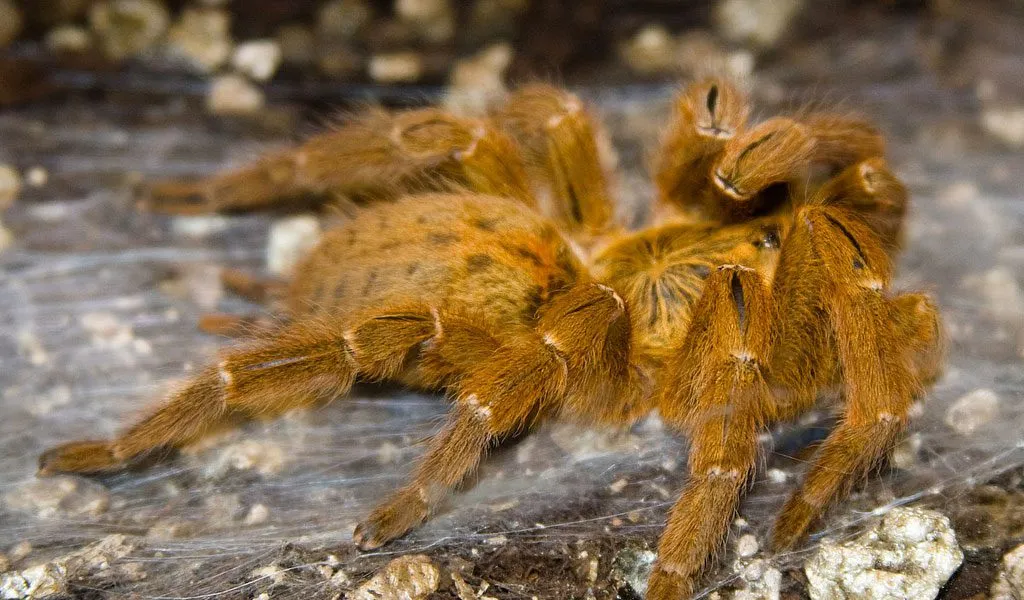What is a Tarantula (Spider)?
Tarantulas are large, hairy spiders belonging to the Theraphosidae family. These impressive arachnids are known for their size, impressive fangs, and diverse appearances. They are found in various habitats around the world, primarily in tropical and subtropical regions. Understanding the basics of what defines a tarantula is the first step in learning how to identify them, as they are often mistaken for other types of spiders. Their sheer size alone can be intimidating, but with the right knowledge, you can learn to appreciate these fascinating creatures from a safe distance.
Defining Characteristics of Tarantulas
Tarantulas possess several defining characteristics that set them apart from other spiders. They have eight legs, two body segments (cephalothorax and abdomen), and two chelicerae (fangs) that they use to inject venom. Their bodies are covered in hairs, which serve various purposes, including sensory perception and defense. The presence of urticating hairs, which they can flick off to irritate predators, is another key characteristic. These features, combined with their size and specific behaviors, help in distinguishing tarantulas from other spider species.
Size and Appearance

One of the most noticeable characteristics of tarantulas is their size. They can range from having a leg span of just a few inches to over 10 inches in some species. Their bodies are typically bulky, with a hairy appearance. Colors and patterns vary greatly depending on the species, ranging from solid browns and blacks to vibrant blues, oranges, and yellows. Some tarantulas have intricate patterns on their abdomens and legs, making them visually stunning. Observing these variations is a crucial part of identifying different types of tarantulas.
The overall appearance of a tarantula provides valuable clues for identification. Their bodies are divided into two main parts cephalothorax and the abdomen, with the cephalothorax housing the head and the legs. The abdomen is typically large and round, and it houses the spider’s internal organs. The legs are long and strong, and are covered in hairs. They also have two chelicerae or fangs that they use to inject venom. The variations in body size, leg span, and overall coloration are the keys when you are looking for identification.
Habitat and Distribution
Tarantulas are found in a wide range of habitats, including tropical rainforests, deserts, grasslands, and even suburban areas. Their distribution spans across the Americas, Africa, Asia, and Australia. Different species have adapted to specific environments, with some living in burrows, under rocks, or in trees. Understanding the typical habitat of a tarantula can help narrow down the possibilities when trying to identify a specific species. For example, the presence of a tarantula in a particular region may suggest certain species are more likely to be found there.
Tarantulas are often found in areas with warm climates, however, they can adapt to a range of environments. Certain species thrive in dry, arid regions such as deserts, where they construct burrows to escape the heat. Other species are more inclined to rainforests, where the conditions are humid and offer lots of cover. In some cases, tarantulas may be encountered in urban or suburban environments. The distribution of tarantulas is a key factor when you are trying to identify the specific species, as it provides essential information about what species may be present in a specific area.
Identifying Tarantula Species
Identifying specific tarantula species requires careful observation and attention to detail. While some species are easily distinguishable, others may require closer examination of specific features. It’s crucial to consult field guides, online resources, and, when possible, experts, to accurately identify tarantulas. The following steps will help you understand the key features, observe the differences in types, and distinguish a tarantula from other spider species. Always remember safety, and observing from a distance is always a key.
Key Features to Observe

Several key features are crucial for identifying tarantula species. These include leg span, body size, coloration, and markings. The size and shape of the spider can provide a starting point for identification, while the coloration and patterns on the body and legs can help narrow down the possibilities. Observing the presence and arrangement of hairs, as well as any unique features, such as the shape of the carapace (the top part of the cephalothorax) or the presence of spurs on the legs, can be very helpful. It’s also useful to note the habitat and behavior of the tarantula, such as whether it lives in a burrow or in a tree.
Leg Span and Body Size
Measuring the leg span and estimating the body size are fundamental steps. Leg span, measured from the tip of one leg to the tip of the opposite leg on the same side, is a useful metric for comparison. Body size, measured from the front of the cephalothorax to the end of the abdomen, is another important factor. Comparing these measurements with known data for different species can help you narrow down your options. It’s best to approach the spider slowly and use a ruler or other measuring tool from a safe distance, if possible. The leg span gives you a fast estimate, and measuring the body gives more detail.
Coloration and Markings
Coloration and markings can vary greatly among different tarantula species. Observe the overall color of the body and legs, as well as any patterns or markings. Some tarantulas have solid colors, such as brown or black, while others have intricate patterns, such as stripes, spots, or bands. Note the color of the hairs, which can range from dark to light or even metallic. Take pictures or make detailed notes of these features, as they are often crucial for accurate identification. Comparing your observations with images and descriptions of known species is a great tool.
Identifying Different Types of Tarantulas

The world of tarantulas includes a vast array of species, each with its unique characteristics. Identifying the type requires understanding the different families, genera, and species. Familiarize yourself with the common species in your area, as well as any species that are known to be present. Researching the distribution and habitat preferences of different tarantulas can help to narrow down your options. Use field guides and online resources to compare the features you observe with the descriptions and images of known species, it will assist in the identification.
Common Tarantula Species
Some tarantula species are more commonly encountered than others. For example, the Mexican Redknee Tarantula (Brachypelma hamorii) is popular as a pet due to its striking appearance. The Texas Brown Tarantula (Aphonopelma anax) is found in the southern United States and is one of the largest spiders. The Chilean Rose Tarantula (Grammostola rosea) is known for its docile temperament and is another common pet species. Learning about these common species, including their appearance, habitat, and behavior, is the first step in the identification of tarantulas.
Less Common Tarantula Species
Beyond the common species, there are many less commonly seen tarantulas. These include species that are rare, localized, or difficult to find. Identifying these species may require more specialized knowledge and resources. Some examples include the Cobalt Blue Tarantula (Cyaneopubescens) known for its vivid blue coloration. The Goliath Birdeater (Theraphosa blondi) is one of the largest spiders in the world. Studying the less common species requires careful research. These species can be difficult to find, as they inhabit very specific habitats. Taking the time to study, research, and appreciate is a key step.
Distinguishing Tarantulas from Other Spiders

Tarantulas are often confused with other large spiders, such as huntsman spiders. However, there are key differences that can help you tell them apart. Paying attention to the overall body shape, the presence of hairs, and web-building habits can help you differentiate tarantulas from other spider species. In case of doubt, it’s always best to consult with an expert or use reliable identification resources. While tarantulas are distinct, the differences are subtle, and understanding how to distinguish them helps make an accurate assessment.
Body Shape and Proportions
Tarantulas have a characteristic body shape with a large, bulky body and long legs. In contrast, some other spiders may have a more elongated or flattened body. The proportions of the different body segments, such as the cephalothorax and abdomen, can also provide clues. Note the relative size of the legs in relation to the body. The overall shape is a key differentiator. Comparing the proportions with known species can help in identification, even from a distance.
Presence of Hairs
The presence of hairs is a significant feature. Tarantulas are typically covered in hairs, which can be long or short, dense or sparse. The presence of urticating hairs, which can be flicked off as a defense mechanism, is another indicator. These hairs are often located on the abdomen. If the spider you are observing does not have hairs, or if the hairs are very short and sparse, it is less likely to be a tarantula. The appearance of hairs is an essential factor when differentiating from other types of spiders.
Web-Building Habits

While some tarantulas create webs, many do not. Tarantulas that do build webs tend to construct simple, silken retreats or tunnels, unlike the elaborate webs created by other spiders. If you see a spider building a complex web, it is less likely to be a tarantula. Observing the web-building habits, or lack thereof, can provide valuable clues. Look for the presence and type of web, and consider the spider’s general behavior to determine if it is a tarantula.
Essential Tools for Identification
Having the right tools can greatly enhance your ability to identify tarantulas. The following tools will allow you to safely observe, record, and research the tarantula, helping you to make an accurate identification. While identifying tarantulas, be sure to always put safety first, and avoid direct contact whenever possible. Proper equipment is your best tool.
Magnifying Glass
A magnifying glass is a valuable tool for examining small details. It allows you to observe the hairs, markings, and other features that may be difficult to see with the naked eye. Use a magnifying glass to inspect the spider from a safe distance. A magnifying glass is useful for looking at the chelicerae, spinnerets, and other unique identifiers. It also makes it easier to differentiate from other types of spiders. Make sure you use it with caution. Always observe with care.
Field Guide or Online Resources

Field guides and online resources provide essential information about different tarantula species. Field guides often contain images, descriptions, and distribution maps that can assist in identification. Online resources, such as websites and databases, offer even more detailed information, including scientific classifications, habitat details, and behavioral traits. Using these resources in conjunction with your observations will improve your ability to identify tarantulas.
Camera or Smartphone
A camera or smartphone is extremely useful for documenting your observations. Take photos of the tarantula from different angles, paying attention to key features such as the leg span, coloration, and markings. These photos can be used for later comparison with field guides or online resources. Having a photographic record will also help if you need to report the sighting. High-quality images are key when comparing to online images.
Important Safety Considerations
Identifying tarantulas should always be done with safety as the highest priority. Tarantulas can bite, and some species possess urticating hairs that can cause skin irritation. It is essential to take precautions to protect yourself. The following advice will help you observe tarantulas safely, minimizing the risk of bites or other injuries. Remember that understanding the species, their behavior, and their potential dangers is key to a safe experience.
Avoid Direct Contact
The most important safety rule is to avoid direct contact with the tarantula. Do not attempt to handle or touch a tarantula, as this can lead to a bite. Always observe the spider from a safe distance. If you need to get a closer look, use a magnifying glass or camera with a zoom lens to observe details. Never provoke a tarantula. Respecting the spider’s space is vital to avoiding any negative interaction.
Observe from a Safe Distance
Maintaining a safe distance is crucial. Keep a respectful distance to avoid startling the tarantula. Use binoculars or a camera with a zoom lens to observe details without getting too close. This approach allows you to appreciate the spider while minimizing the risk of any interaction. If you are in an area where tarantulas are common, be mindful of your surroundings and watch where you step or reach.
Reporting Tarantula Sightings
If you come across a tarantula, consider reporting your sighting to local authorities or wildlife organizations. Reporting helps in monitoring the distribution and population of these spiders, which in turn helps with scientific research and conservation efforts. Provide details such as the location, the species (if known), and any other relevant information. This information can be valuable to scientists and conservationists. Reporting is essential to protecting these species, and to understand the distribution.
In conclusion, identifying tarantulas can be a rewarding experience. With knowledge, observation, and respect for these creatures, you can appreciate their beauty and learn about the world around us. The combination of understanding their characteristics, key features, and safety precautions is critical. Whether you are an expert or a beginner, the journey of identifying tarantulas is always full of adventure.
